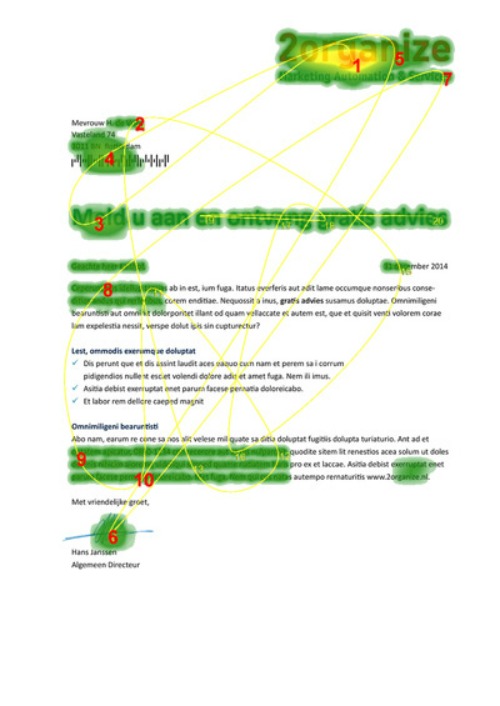Most nonprofits, without realizing it, make a big assumption when they write their fundraising.
They assume their donors will read the whole thing. The whole email. The whole letter.
That’s a really unhelpful assumption.
Here’s a heatmap of a 1-page direct mail letter. It shows what a donor’s eyes tend to look at, and in what order it happens:
We could spend a lot of time talking about what this means for your fundraising writing and design. But there’s one main lesson I want you to take away…
You Have to Earn and Keep a Donor’s Attention
You cannot assume your donor will read the whole thing.
Well, you can. But you’ll raise a lot less money.
So first you have to earn your donor’s attention. That’s having a great teaser on your envelope. Or a catchy subject line for your email. You need to get good at those things.
For your mass donor fundraising to excel, you need to be better at earning attention than you need to be at describing your organization or your programs.
That might feel like a “sad truth.” But it’s a really helpful truth if you want to raise more money and do more good.
How to Earn Donor Attention
There are three main ways to earn donor attention. You need to make your fundraising:
- Interesting to donors. This almost always means talking about your beneficiaries and your cause more than your organization and your programs. Remember: your donor first got involved because of your beneficiaries or cause, not because of your programs.
- Emotional. Emotions are what keep us reading. You want to constantly be using the emotional triggers: Anger, Exclusivity, Fear, Flattery, Greed, Guilt, Salvation.
- Dramatic. You want your fundraising to be full of drama and conflict.
Here’s an example. You already know that your first sentence of any fundraising appeal is super important. Take a look at these two:
“[NAME] Theatre is dedicated to producing high-quality, daring productions that take on challenging topics.”
vs.
“I’m writing you today about something you care about – and it’s in danger.”
I can basically guarantee you that more people are going to keep reading the second example. It’s written directly to the donor, it’s about something she cares about; it’s emotional, and it’s dramatic.
The first example – from a real letter from my files – is a classic example of telling the donor something the donor probably already knows and doesn’t really care about.
Note: Arts organizations often say that their fundraising can’t be emotional or dramatic because they don’t have babies or puppies to raise money for. I think the first example above shows that Arts organizations can absolutely be dramatic and emotional in their fundraising – they just need to think about it differently. After all, if a Theatre can’t get dramatic, it’s probably not that great a Theatre!
The Big Lesson
Your donors are moving fast. They don’t read the whole thing, watch the whole thing, or listen to the whole thing.
You need to get great at getting and keeping their attention. Study it. Know what your donors care about and then borrow tactics from advertising and social media to get your donor’s attention. And remember; we have 70 years of best-practices for earning and keeping donor attention. Smart fundraisers have learned a LOT over the years. Tap into it!
Because if you can earn your donors’ attention, they are more likely to keep reading.
And if you can keep your donors’ attention, they are more likely to give you a gift.



